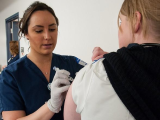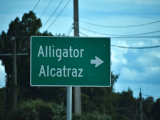Feb 14, 2008 (CIDRAP News) – The World Health Organization (WHO) today reported evidence of a less-than-satisfactory match between all three components of this season's influenza vaccine and the flu strains currently making people sick.
Last week US health officials reported mismatches between the influenza A/H3N2 and influenza B components of this year's vaccine and the circulating H3N2 and B strains. Today the WHO reported that the majority of recent H1N1 virus isolates globally have not matched well with the H1N1 component of the vaccine.
As a result, the WHO today recommended replacing all three components in next year's flu vaccine for the northern hemisphere.
H1N1 is the flu subtype that has begun to show resistance to the antiviral drug oseltamivir (Tamiflu), one of the two neuraminidase inhibitors recommended for flu patients. In a separate update today, the WHO said H1N1 viruses with a resistance mutation have been found in 18 of 37 countries where the viruses have been analyzed. The mutation was observed in 14% of the isolates studied, including 8% of those in the United States.
Each February the WHO assesses the flu virus strains in circulation before picking the strains for the next northern hemisphere flu season. It takes about 6 months for vaccine manufacturers to grow the viruses in chicken eggs and formulate them into trivalent (three-strain) vaccines. Changing one or two strains is not unusual, but replacing all three is less common.
The WHO recommended the following for next season's vaccine:
- For the H1N1 component, a strain similar to A/Brisbane/59/2007, replacing A/Solomon Islands/3/2006
- For the H3N2 component, a strain similar to A/Brisbane/10/2007, replacing A/Wisconsin/67/2005
- For the B component, a strain similar to B/Florida/4/2006, replacing B/Malaysia 2506/2004
The Brisbane strains of H1N1 and H3N2 will be used in this year's vaccine for the southern hemisphere, where the flu season runs from May through October, according to the WHO.
The agency said H1N1 viruses were the predominant flu subtype in most parts of the northern hemisphere from September through January, though flu activity in that period was generally low in comparison with the same interval in recent years.
While some H1N1 viruses analyzed this season were similar to the Solomon Islands strain used in the vaccine, "the majority of recent isolates were distinguishable from the vaccine virus and antigenically similar to A/Brisbane/59/2007," the WHO report states.
The report says that in lab tests, serum samples from people immunized with this year's vaccine generated a lower antibody response to recent H1N1 isolates than to the Solomon Islands H1N1 strain used in the vaccine. For example, 93% of adult samples generated a significant antibody response (titre of 40 or higher) to the Solomon Islands strain, but only 59% of adult samples generated a similar response to recent isolates. However, the WHO offered no comment on the clinical significance of the findings.
The US Centers for Disease Control and Prevention (CDC) reported last week that 46 of 53 H3N2 viruses it had tested through Jan 26 were similar to A/Brisbane/10/2007, which evolved from the Wisconsin strain used in the vaccine. The CDC also said 40 of 43 influenza B viruses tested belonged to the Yamagata lineage, not the Victoria lineage represented by the Malaysia strain used in the vaccine. (A CDC update today, covering the period through Feb 2, did not list any new numbers for the circulating strains.)
The CDC has not cited a problem with the H1N1 component of the vaccine. The agency did not return a call today in time to comment on the WHO report, but it has scheduled a briefing tomorrow on the flu season.
As recently as Jan 31, the WHO, in reporting on the resistance of H1N1 viruses to oseltamivir, said the H1N1 strain used in this season's vaccine was well-matched to the circulating strains.
In today's update on the oseltamivir resistance problem, the WHO said 237 (14%) of 1,703 H1N1 viruses tested so far had the mutation conferring resistance. Resistance rates are highest in Norway (66% of isolates), France (40%), and Luxembourg (25%).
See also:
Full WHO report and recommendation for strains to be used in next season's vaccine
http://www.who.int/influenza/vaccines/recommended_compositionFeb08FullReport.pdf
WHO vaccine-composition recommendation only
http://www.who.int/influenza/vaccines/vaccinerecommendations1/en/index3.html
WHO summary table of H1N1 resistance to oseltamivir
http://www.who.int/influenza/resources/documents/H1N1webupdate20090318_ed_ns.pdf
CDC's weekly flu surveillance report
http://www.cdc.gov/flu/weekly/




















